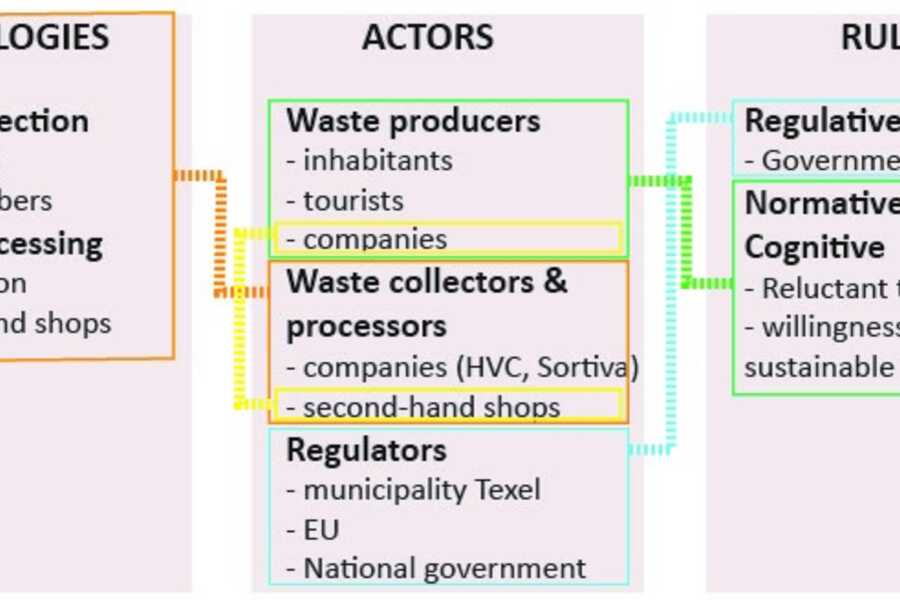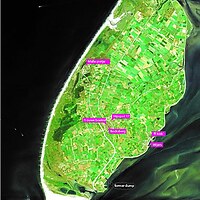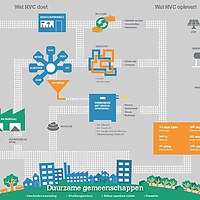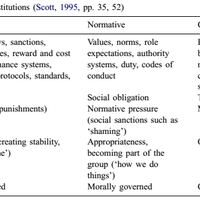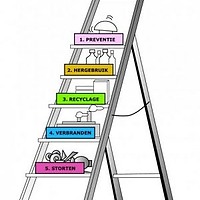Contents
2.2 General data on the sub-system of waste in The Netherlands.
2.3 Elements of the sociotechnical subsystem: Technology, Actors & Rules.
2.3.3 Rules within the socio-technical system.
2.3.4. How are the technologies embedded in culture & behavior?
2.4 The major unsustainable mechanisms in the waste sub-system.
2.5 Major trends, developments and initiatives that are relevant to the transition of the system.
2.1 Introduction
Waste itself is not a new phenomenon, but the size and the composition of the waste streams are. There seems to be a correlation between economic prosperity and production of waste: the worldwide waste production is larger than ever and keeps on growing. In bad economic times, such as the oil crisis of seventies or the recession of the eighties and the period since 2007, the production of waste (slightly) decreases. Something to realize is that waste does not exist in the ideal recycle world. What is waste for one organism, can be food for the next organism. However, it is doubtful whether this ideal world of cradle to cradle is realistic. Within this concept we try to realize an island that gets as close to this as realistically possible.
This section starts with some data on the subsystem of waste, will then continue to describe the various elements of the sociotechnical sub-system; technologies, actors and rules. A section on how these elements are interrelated is included a section about what the major unsustainabilities mechanisms of the system are. We finalize this chapter with a section on the major trends, developments and initiatives that are relevant to the transition of the system.
2.2 General data on the sub-system of waste in The Netherlands
As stated before, the average waste production of a person in the Netherlands is 530 kg per year, four times as much as in 1950. In the Netherlands 49% of household waste is collected separately, the remaining 51% is unsorted household waste. The main components of household waste are organic (vegetables, fruit and garden), paper and cardboard waste. 60% of all disposed paper and glass is recycled, of plastic this is only 13%. An average household has much more products than in former times and these products have gotten a higher turnover. We repair and re-use our clothes and furniture less often: it’s much easier to just buy new cheap furniture at the IKEA or clothes at the H&M. In contrary, some waste streams like coal ash have decreased due to changing mechanisms in society (Nabielek, 2014).
But the household waste is only a small part of the total waste stream: 85% of all waste comes from companies. That is another 3,079 kg waste per person in the Netherlands every year.
Texel has a higher average of household waste per person per year: almost 700 kg. It is likely that the presence of the tourist industry has a large share in that waste. Tourists consume a lot and produce lots of waste. Numbers on the type of household waste are shown in table 1. Data on waste produced by companies on Texel are not known. In the table, only the types of waste that were counted are included.
Table 1 Household waste on Texel in 2012 source: (CBS, 2012)
|
Type of waste |
Kg p.p./year |
|
Residual waste |
278 |
|
Bulky waste |
51 |
|
Construction waste |
11 |
|
Organic waste |
106 |
|
Paper, cardboard |
64 |
|
Glass |
51 |
|
Textiles |
0 |
|
Bulky garden waste |
97 |
|
Wood waste |
24 |
|
Bituminous roofing |
3 |
|
Total |
685 |
2.3 Elements of the sociotechnical subsystem: Technology, Actors & Rules
In the sociotechnical sub-system of waste we distinguished three major categories of elements; technologies, actors and rules. In the following subchapters these elements and their characteristics are described.
The elements cannot be seen apart from each other: they are strongly interconnected. For instance, the government decides the amount of tax money that civilians have to pay for having their waste to be disposed and then appoints a company that disposes the waste. In figure 1 some of the interrelations are visualized. The possible activities of actors depend on what technologies are available. Their activities are bounded by the rules set by the regulators.
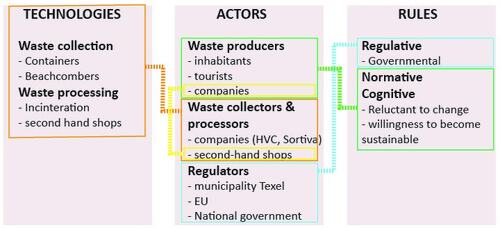
Figure 1 The three major elements of the sociotechnical sub-system of waste and their interrelations. The interrelations are discussed in sections 2.3.1 – 2.3.3.
2.3.1 Technologies
The technologies that concern waste, can be divided in technologies of waste collection and waste processing. Note that we only included technologies that are currently deployed in Texel.
Waste collection. The household waste on Texel is collected separately by the cleaning services of the municipality: residual waste in grey mini containers and organic waste in green mini containers. These containers are collected every other week by the municipality, but residents can also use the public containers close to their home. In every neighborhood, separated public containers are located for paper/cardboard, plastic, glass and textile and small chemical waste. Bulk waste will be collected on request on Tuesdays (Gemeente Texel, n.d.). Something to notice is that an initiative to chip the containers of the Texel civilians was cancelled.
A special way of collecting waste are the beachcombers (in Dutch: strandjutters). They collect stranded materials and in the same time clean the beaches.
Waste processing. The processing of waste in the Netherlands looks rather organized. While in the eighties the waste mostly ended on landfill, nowadays the waste streams are properly organized and waste is either recycled or incinerated for energy recovery. Over 75% of the waste is recycled and about 20% goes to the combustion plant where electricity and heat is generated. 2% ends up in landfill.
The Dutch combustion plants currently have overcapacity, therefore waste from other countries gets imported. In this way the Netherlands can create energy of foreign waste while saving the nature since that waste otherwise would have been dumped there. The produced energy is good for the Dutch economy. This causes a ‘lock-in’: the existing plants want to keep on burning waste to create energy and bother he recycling processes.
Texel does not have a place to process their waste: the waste is shipped to the main land to be processed. Not all ‘waste’ is brought to a container however: there are several second hand shops on Texel that buy and sell used articles. These shops are shown in figure 2. Specified data on where the waste of Texel gets processed is unknown, but the processing plant of HVC in Alkmaar seems the most logical place.
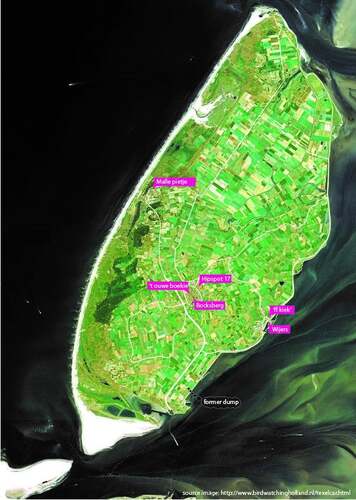
It can be assumed that a large quantity of the waste of Texel goes to one of the combustion plants of HVC on the main land. As figure 3 shows, the activities of HVC also include second hand shops, recycling, fermentation and incineration with energy generation.
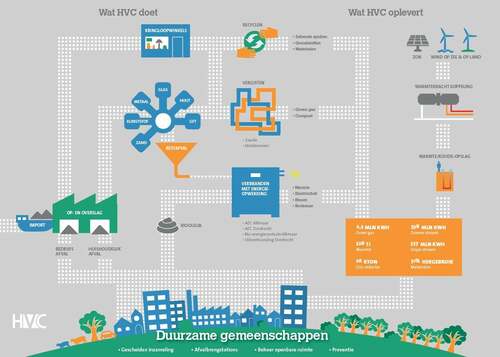
2.3.2 Actors
The main actors belonging to the materials and waste sub-system of the island can be divided in the waste producers, waste collectors/processors and the regulators.
Waste Producers. Within this category fall the actors that are creating the waste; inhabitants of the island, the tourists visiting the island and the companies and industries on the island.
The interest of the inhabitants of the island is to keep the island clean, because they are proud of their place, while we know from the classes that most of them do not want radical changes in their everyday rhythm. Their need is an easy way to deal with waste. At the moment, the separation rate is not optimal yet, since an analysis in 2012 showed that around 34% of the category “other waste” that was thrown in the grey bin consisted of compostable waste. Table
We can assume that most of the tourists help in keeping the island a clean place, in order to be visited and enjoyed again in the future. What they need is, like the inhabitants, an easy and accessible way to deal with waste and a clean place to be enjoyed. Again, this is an assumption, but it seems reasonable that (almost) nobody dumps his waste on purpose if there is a good alternative like a bin. However, separating the waste still seems to be a tough challenge for the tourists, since most of the bins for compostable waste at recreational homes has to be treated as regular waste because it has not been separated well enough (Gemeente Texel, 2013).
The companies want to dispose their waste in a low-cost and legal way, by following the legislations and the waste disposal management of the municipality. Companies on Texel are free to sign contracts with an acknowledged waste processor. Such a contract includes information about the type of waste, average amount of waste, frequency of collecting, size and amount of containers, collection day. The municipality also offers collecting services for waste of companies (De digitale balie, n.d.). Currently, HVC is the biggest waste collector on Texel.
Waste Collectors & Processors. The main actors in this category are HVC and Sortiva, which is a joint venture between HVC and De Groot.
Sortiva is the company that is currently recycling paper, glass, rubble and bulky items on the island (Green Islands Network, 2014) The interest of the company is to increase the amount of recycled materials, which would decrease the incinerated waste on the mainland, resulting in higher profits. The need of a recycling company is that all the people and tourists have the possibility and good attitude in separation of waste.
HVC is the company that provides the waste management on the island. They already collect and transport the waste to Alkmaar for incineration. Their expectation is an improved waste management plant for energy production, in which the cooperation and investments of the municipality is very important (HVC Groep, 2014).
Regulators; Waste issues are regulated by three governmental bodies; the Texel municipality, the Netherlands and the European Union. The rules itself are further explained in section 2.3.3.
We assume that the main interest of the Texel municipality is to keep the island as clean as possible, in order to improve the tourism industry, from which the whole island benefits. This assumption is based upon regulations explained in section 2.3.3. This can be illustrated by the fact that the Texel municipality has recently increased its goals for source recycling (the separation of waste by the source, so the inhabitants of Texel) towards 65%, 5% higher than the national guidelines advise.
The Netherlands main focus is turning the island of Texel into an energy sufficient island, as discussed and approved in early 2007. This involves also the incineration process directly on Texel, because it can be a good asset for the energy production and at the same time result in less energy use for waste transportation.
2.3.3 Rules within the socio-technical system.
Within the system there are several important rules and regulations. Geels (2002) reports on three types of rules: regulative, normative and cognitive rules which are depicted in figure 4 (Geels, 2002). On the regulatory level we have analyzed the policies that are written by the Texel government, since these kind of regulations are implied on a local level, sometimes following national or European directives. The documents were found on the government website by scanning the local policies on waste directives and by looking for regulations on beaches and sewage, which we consider also important.
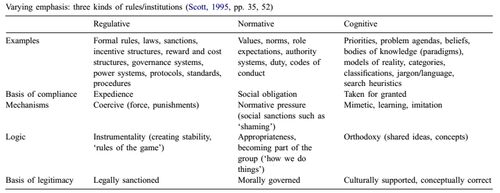
Exploring the normative rules is a bigger challenge. Normative rules confer values, norms, role expectations, duties, rights, responsibilities. It is about the norms in society and how society expects people to treat their waste. It will probably be tough to find out the actual norms on this because Geels notes that these tend to be unwritten. Finally, cognitive rules constitute the nature of reality and the frames through which meaning or sense is made. Paradigms on how people interact with waste and if they perceive it as valuable would be a more tangible definition of this concept in my opinion. An example could be the earlier mentioned “jutterscultuur” of Texel which used to be an important part of the cultural heritage of Texel and should be considered as a more informal set of rules. The informal norms on waste treatment in Texel would be an interesting further investigation and maybe an idea for our interview topic.
Regulative Rules In the societal needs part we distinguished six points on which current policy focuses. We implicitly assumed that the current policy was enough to cover the societal needs, but this could be further explored by an investigation of the norms on waste treatment as proposed earlier. If we analyze the current policy on these six points, we come to the following conclusions. The policies mentioned below are from the document Grondstoffenplan from the Texel government, but these are based upon European and national directives. Therefore, alterations in these regulations should also fit into the overruling directives. The overall principle in the European directives is that the polluter pays. In the national directive, the guideline is provided by the so called “Ladder van Lansink” which is visualized in figure 5 (Gemeente Texel, 2013).
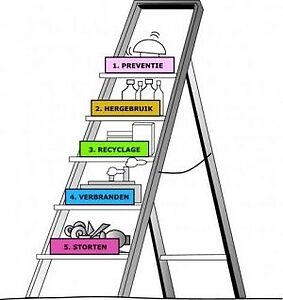
Combining these principles means that waste should be treated as much as a resource as possible and those who do not comply with these principles are the ones who pay the price of the steps that have to be taken to get rid of the waste. An example of this is the removal fee, a national law which has to be paid if one buys a new apparatus. We continue below with the different regulations on the several focus points.
- Waste disposal – Glass, compostable waste, paper, plastics and other wastes are collected separately or policy to collect it separately has been passed. The percentage of separation in Texel is about 50%, compared to 61% in comparable districts. The government aims to get 65% separation by 2020.
- Waste Re-usage - For our cradle to cradle approach, it is specifically important to consider what is done with the waste after it has been collected. Texel aims to re-use 70% of its waste in 2020, which is higher than the general Dutch aim of 65 % by 2020. The purpose is to have as much of the waste processed on the island itself, otherwise it should be transported as efficiently as possible to the main land. It has been researched whether an anaerobic digester on the island for the purpose of gas and energy extraction from compostable waste would be cost-efficient but this was not the case in 2002. Recently, new plans have been presented and these and other initiatives are evaluated on their cost-efficiency and technical feasibility, which seems to be the general principle for these initiatives on the island.
- Waste Amount – As explained earlier, the one who pollutes pays. General waste taxes are asked to every citizen, where the amount is differentiated for single households, family homes and recreational homes. There are around 2000 single households, 4000 families and 1200 recreational homes on Texel that pay waste taxes. Companies have to pay an amount that depends on the type of waste and the amount of collections per year (Decentrale Regelgeving Overheid, 2013). Something noticeable is that it is cheaper to have “general waste” collected than “compostable waste”. This is probably not stimulating the separation of waste by companies.
- Waste collection systems camouflage – Plans for this are developed in the form of underground collecting systems which have to be finished by 2015.
- Waste in nature and streets – The new waste collection systems have to help the prevention of waste in nature. In general, there isn’t a lot of waste in the nature and on the streets of Texel, according to research that was performed by the government.
- Clean beaches – The hospitality industry on the beach is responsible for cleaning up the beaches up to 25 meters surrounding their restaurant or beach bar. Beyond this, it is the duty of the government that cleans it up according to the demand, but at least twice a year the entire beach is cleared from waste. On top of this, people can signal the government when a bin has to be emptied which will be done as soon as possible.
Normative and Cognitive Rules. As noted earlier, information on the normative and cognitive rules will be hard to find. Below we discuss some small insights and we discuss how we can alter these sets of rules.
Since we want to re-design the waste streams on Texel towards a cradle-to-cradle design, a way to look into these normative and cognitive rules would be to see how concepts from circular business models are perceived in Texel. A start has been given with the national MyBeach initiative, where it is basically not done to leave your waste on the beach. These norms are spread via the hospitality industry, volunteers and schools (Gemeente Texel, 2013). According to the MyBeach website, at least 6 companies are participating on the Texel beach (MyBeach, 2014).
The cognitive rules set also reports on priorities and beliefs. We have been taught in the lectures that people from Texel are resistant to change and the cognitive set of rules is probably a conservative one on a lot of areas.
2.3.4. How are the technologies embedded in culture & behavior?
Waste is part of the everyday life for both households and companies. It includes separating the waste (paper, organic material, clothes, glass and so on), bringing the waste to a collection point, and sometimes even buying ‘waste’ of others (in second hand shops). These daily routines are already embedded in the behavior of the inhabitants. However, the separation of waste on Texel can be lifted to a higher level: currently most households and companies recycle only 13% of the plastics and 60% of paper, cardboard and glass. In the ideal future situation, this percentage increases to a 100%. This will be discussed in the next chapter.
Culture also plays a role in waste, as explained in section 2.3.3. In some countries it is normal to throw waste on the street, what leads to enormous pollution and unsafe situations due to the lack of hygiene. Fortunately the culture in the Netherlands differs from that. Dutch people are quite neat with their public space. However, Texel also has many tourists. The culture of the tourists may differ from the Dutch ‘neat’ culture. We assume though, that tourists will clean up their mess if this is easily facilitated.
2.4 The major unsustainable mechanisms in the waste sub-system
The following unsustainabilities of the waste system on Texel have been determined by us.
- The high turnover of products: a lot of products are disposable. Consumables do not last long enough and disposables (like packaging material) are aplenty. This is not a specific problem for Texel but for the whole world.
- The 51% of the household waste that not is recycled is not sustainable. This is a opportunity for improvement. The behavior of people (their mindset) can be more sustainable towards separating the waste.
- The way of processing can be more sustainable. Initiatives like the anaerobic digestion system on the island could help with this.
- Technologies can be improved in terms of sustainability.
- Regulations for company waste disposal seem to be disfavoring separation of waste, since the cheapest option is to dispose all the waste as ‘general waste’.
For a circular economy where we, and a growing number of companies and regions, aim for requires changes in the system. Products and their materials have to be designed in such a way that the materials can easily be recovered and the end of the product lifecycle. Thus, waste prevention and re-use play a keyrole for a circular economy. Also, a shift from buying or selling products to buying and selling (or sharing) services would help. The term ‘sharing economy’ (deel economie) is getting more popular and initiatives such as Peerby, Snappcar, Little Green Dress, Airbnb are multiplying.
2.5 Major trends, developments and initiatives that are relevant to the transition of the system?
As mentioned before, a good campaign that is already active on the island and along the entire coast is “My beach”. Thanks to it, the beaches are cleaned out of the waste plastics coming from touristic activities before they can get into the sea and pollute it, and they are used to decorate big and fancy sculptures. The people involved are volunteers and the owners of the pavilions located on the beaches. The idea has a double effect: it cleans the beaches, while it contributes for social engagement and creation of a funny activity, where also kids can be involved. In summer, when the tourism rate is higher, the collection of waste is organized weekly (MyBeach, 2014).
A current initiative that is very good for waste reduction is the packaging-free market, which hopefully will become more and more common. An example is the one that will open in the city of Berlin. It is a market where the food is not wrapped in packages, and the consumers bring their own containers, that will be weighted at the entrance. It is a way to reduce the waste coming from the packaging but not only. It results also in a reduction of the food and products bought, because there will not be as much choice as in normal markets, helping also in decreasing nowadays’ consuming mentality (Borromeo, 2014).
A growing number of technologies are being lately developed for waste treatment combined with energy production. One of them uses anaerobic digestion. Anaerobic digestion is a series of processes, where microorganisms are able to break down biodegradable material in absence of oxygen. When used as part of the waste management system, the anaerobic digestion can reduce the emission of landfill gases while producing renewable energy. The process’s product is a biogas containing methane, carbon dioxide and other gases. This biogas can be used as fuel or be improved to become bio-methane, while the remaining materials of the digestion process are highly nutrient-rich and can be used as fertilizer. With the re-use of waste and the production of biofuel this technology is being more and more applied lately, especially by UK, Germany and Denmark (American Biogas Council, sd) .
Another process that can be used for a sustainable treatment of biodegradable and plastic waste is the Gasification process. It converts organic or fossil fuel into carbon monoxide, hydrogen and carbon dioxide, by using high temperatures, without combustion and controlled amount of oxygen and steam. The gas resulting from the process is called syngas, which is considered a renewable energy source, when obtained by biomass. Using syngas instead of burning the initial waste or fuel is more efficient because it can be combusted at higher temperatures or also in fuel cells (Wikipedia.org, sd).
A similar process that converts organic materials into syngas using plasma, is called Plasma gasification. It ionizes gas and catalyzes organic matter into syngas. Many are the advantages: it provides a clean way of disposing hazardous waste, preventing them to reach landfill; it does not result in toxic waste emissions, while it provides clean alloyed slag that can be used as construction material; it turns organic waste into combustible syngas for electric power and thermal energy (Dodge, 2014; Wikipedia.org, sd)
Bibliography
American Biogas Council. (sd). What is Anaerobic Digestion? Opgeroepen op November 24, 2014, van American Biogas Council: http://www.americanbiogascouncil.org/biogas_what.asp
Borromeo, L. (2014, September 16). Berlin duo launch a supermarket with no packaging. Opgeroepen op November 24, 2014, van The Guardian Sustainable Business: http://www.theguardian.com/sustainable-business/2014/sep/16/berlin-duo-supermarket-no-packaging-food-waste
CBS. (2012). Statline: huishoudelijk afval per bewoner. Opgeroepen op 11 18, 2014, van Centraal bureau voor de statistiek: http://statline.cbs.nl/Statweb/publication/?DM=SLNL&PA=80563ned&D1=0-27&D2=437&D3=a&HDR=T&STB=G1,G2&VW=C
De digitale balie. (sd). Afvalinzameling, bedrijven. Opgeroepen op 11 16, 2014, van Gemeente Texel: http://www.texel.nl/de-digitale-balie/overzicht-producten_42399/product/afvalinzameling-bedrijven_291.html
Decentrale Regelgeving Overheid. (2013, November 11). Gemeente Texel: Verordening op de heffing en de invordering van afvalstoffenheffing en reinigingsrechten 2014. Opgeroepen op November 2014, 24, van Overheid.nl, decentrale regelgeving: http://decentrale.regelgeving.overheid.nl/cvdr/xhtmloutput/historie/Texel/310543/310543_1.html
Dodge, E. (2014, November 24). Plasma gasification: Clean renewable fuel through vaporization of waste. Opgehaald van Waste Management World: http://www.waste-management-world.com/articles/print/volume-10/issue-4/features/plasma-gasification-clean-renewable-fuel-through-vaporization-of-waste.html
Geels, F. (2002). Technological transitions as evolutionary reconfiguration processes: a multi-level perspective and a case-study. Research Policy, 31(8-9), 1257–1274.
Gemeente Texel. (2013, December 18). Grondstoffenplan. Opgehaald van Gemeente Texel - Beleidsstukken: http://www.texel.nl/de-gemeente/beleidsstukken_42781/item/grondstoffenplan_40903.html
Gemeente Texel. (sd). Afvalinzameling, huishoudelijk afval. Opgeroepen op 11 18, 2014, van Gemeente Texel: http://www.texel.nl/de-digitale-balie/overzicht-producten_42399/product/afvalinzameling-huishoudelijk-afval_461.html
Green Islands Network. (2014). Netherlands: Texel. Opgeroepen op November 15, 2014, van Globalislands.net: http://www.globalislands.net/greenislands/index.php?region=8&c=27
HVC. (sd). Activiteiten. Opgeroepen op 11 23, 2014, van hvcgroup: http://www.hvcgroep.nl/particulier/over-hvc/activiteiten
HVC Groep. (2014). Visie, missie en strategie. Opgeroepen op November 23, 2014, van HVC groep: http://www.hvcgroep.nl/particulier/over-hvc/visie-missie-en-strategie
MyBeach. (2014). Boskalis MyBeach CleanUp tour 2014. Opgeroepen op November 24, 2014, van MyBeach: http://www.mybeach.info/
Nabielek, K. (2014). Afval. In M. Hajer, & T. Dassen, Slimme steden (pp. 153-163). Den Haag: nai010 uitgevers/PBL uitgevers.
Wikipedia.org. (sd). Gasification. Opgeroepen op November 24, 2014, van Wikipedia: http://en.wikipedia.org/wiki/Gasification
Wikipedia.org. (sd). Plasma Gasification. Opgeroepen op November 24, 2014, van Wikipedia.org: http://en.wikipedia.org/wiki/Plasma_gasification

